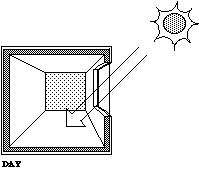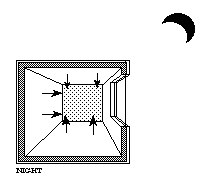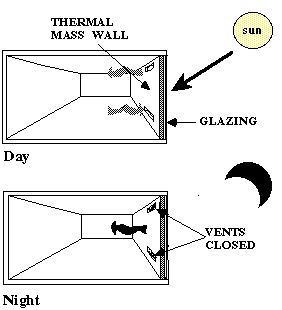- 2.1 Two primary elements of passive solar heating are required:
- South facing glass
- Thermal mass to absorb, store, and distribute heat
There are three approaches to passive systems - direct gain, indirect gain, and isolated gain. The goal of all passive solar heating systems is to capture the sun's heat within the building's elements and release that heat during periods when the sun is not shining. At the same time that the building's elements (or materials) is absorbing heat for later use, solar heat is available for keeping the space comfortable (not overheated).
- 2.2 Direct Gain
In this system, the actual living space is a solar collector, heat absorber and distribution system. South facing glass admits solar energy into the house where it strikes directly and indirectly thermal mass materials in the house such as masonry floors and walls. The direct gain system will utilize 60 - 75% of the sun's energy striking the windows.


Figure 1
Thermal mass in the interior absorbs the sunlight and radiates the heat at night
In a direct gain system, the thermal mass floors and walls are functional parts of the house. It is also possible to use water containers inside the house to store heat. However, it is more difficult to integrate water storage containers in the design of the house.
The thermal mass will temper the intensity of the heat during the day by absorbing the heat. At night, the thermal mass radiates heat into the living space.
- 2.2.1 Direct gain system rules of thumb (Austin):
- A heat load analysis of the house should be conducted.
- Do not exceed 6 inches of thickness in thermal mass materials.
- Do not cover thermal mass floors with wall to wall carpeting; keep as bare as functionally and aesthetically possible.
- Use a medium dark color for masonry floors; use light colors for other lightweight walls; thermal mass walls can be any color.
- For every square foot of south glass, use 150 pounds of masonry or 4 gallons of water for thermal mass.
- Fill the cavities of any concrete block used as thermal storage with concrete.
- Use thermal mass at less thickness throughout the living space rather than a concentrated area of thicker mass.
- The surface area of mass exposed to direct sunlight should be 9 times the area of the glazing.
- Sun tempering is the use of direct gain without added thermal mass. For most homes, multiply the house square footage by 0.08 to determine the amount of south facing glass for sun tempering.
- 2.3 Indirect Gain
In an indirect gain system, thermal mass is located between the sun and the living space. The thermal mass absorbs the sunlight that strikes it and transfers it to the living space by conduction. The indirect gain system will utilize 30 - 45% of the sun's energy striking the glass adjoining the thermal mass.
There are two types of indirect gain systems:
- Thermal storage wall systems (Trombe Walls)
- Roof pond systems
- 2.3.1 Thermal storage wall systems:
The thermal mass is located immediately behind south facing glass in this system.
 Figure 2
Figure 2
Thermal Mass Wall or Trombe Wall Day and Night Operation
Operable vents at the top and bottom of a thermal storage wall permit heat to convect from between the wall and the glass into the living space. When the vents are closed at night radiant heat from the wall heats the living space.
- 2.3.2 Roof pond systems
Six to twelve inches of water are contained on a flat roof.
This system is best for cooling in low humidity climates but can be modified to work in high humidity climates. (Effectively provides heat in southern U.S. latitudes during the heating season for one story or upper stories of buildings.)
Water is usually stored in large plastic or fiberglass containers covered by glazing and the space below is warmed by radiant heat from the warm water above.
These require somewhat elaborate drainage systems, movable insulation to cover and uncover the water at appropriate times, and a structural system to support up to 65 lbs/sq ft dead load.
- 2.3.3 Indirect gain system rules of thumb for thermal storage walls
- The exterior of the mass wall (toward the sun) should be a dark color.
- Use a minimum space of 4 inches between the thermal mass wall and the glass.
- Vents used in a thermal mass wall must be closed at night.
- A well insulated home (7-9 BTU/day-sq. ft.-degree F) will require approximately 0.20 square feet of thermal mass wall per square foot of floor area or 0.15 square foot of water wall.
- If movable night insulation will be used in the thermal wall system, reduce the thermal mass wall area by 15%.
- Thermal wall thickness should be approximately 10-14 inches for brick, 12-18 inches for concrete, 8-12 inches for adobe or other earth material and at least 6 inches for water.
- 2.4 Isolated Gain
An isolated gain system has its integral parts separate from the main living area of a house. Examples are a sunroom and a convective loop through an air collector to a storage system in the house. The ability to isolate the system from the primary living areas is the point of distinction for this type of system. (See Figure 3)
The isolated gain system will utilize 15 - 30% of the sunlight striking the glazing toward heating the adjoining living areas. Solar energy is also retained in the sunroom itself.
Sunrooms (or solar greenhouses) employ a combination of direct gain and indirect gain system features. Sunlight entering the sunroom is retained in the thermal mass and air of the room. Sunlight is brought into the house by means of conduction through a shared mass wall in the rear of the sunroom, or by vents that permit the air between the sunroom and living space to be exchanged by convection.
The use of a south facing air collector to naturally convect air into a storage area is a variation on the active solar system air collector. These are passive collectors. Convective air collectors are located lower than the storage area so that the heated air generated in the collector naturally rises into the storage area and is replaced by return air from the lower cooler section of the storage area. Heat can be released from the storage area either by opening vents that access the storage by mechanical means (fans), or by conduction if the storage is built into the house.
 Figure 3
Figure 3
Day and Night Operation of a Sunroom Isolated Gain System
The sunroom has some advantages as an isolated gain approach in that it can provide additional usable space to the house and plants can be grown in it quite effectively.
The convective air collector by comparison becomes more complex in trying to achieve additional functions from the system. This is a drawback in this area where space heating is less of a concern than in colder regions where the system would be used longer. It is best to use a system that provides more than one function if the system is not an integral part of the building. The sunroom approach will be emphasized in this information since it can provide multiple functions.
- 2.4.1 Sunrooms
Sunrooms can feature sloped and/or overhead glass, but is not recommended for the Austin area. A sunroom will function adequately without overhead or sloped glazing. Due to long hot summers in this area, it is important to use adequate ventilation to let the heat out. Sloped or overhead glazing is also a maintenance concern. Due to the intensity of weather conditions for glazing facing the full .i.ventilation: passive design and brunt of the sun and rain, seals between the gazing panels need to be of extremely high material and installation quality.
A thermal wall on the back of the sunroom against the living space will function like the indirect gain thermal mass wall. With a thermal wall in the sunroom, the extra heat during the day can be brought into the living space via high and low vents like in the indirect gain thermal wall.
More elaborate uses of the heated air generated in the sunspace can be designed into this system, such as transferring the hot air into thermal mass located in another part of the house.
- 2.4.2 Isolated Gain rules of thumb for sunrooms:
- Use a dark color for the thermal wall in a sunspace.
- The thickness of the thermal wall should be 8-12 inches for adobe or earth materials, 10-14 inches for brick, 12-18 inches for (dense) concrete.
- Withdraw excess heat in the sunroom (if not used for warm weather plants) until the room reaches 45 degrees and put the excess heat into thermal mass materials in other parts of the house.
- For a sunroom with a masonry thermal wall, use 0.30 square feet of south glazing for each square foot of living space floor area. If a water wall is used between the sunroom and living space instead of masonry, use 0.20 square feet of south facing glass for each square foot of living area.
- Have a ventilation system for summer months.
- If overhead glass is used in a sunroom, use heat reflecting glass and or shading systems in the overhead areas.

